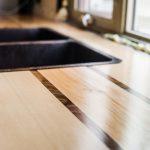A methodology that guides the way to creating healthy and productive habitats for modern human beings, Biophilic Design is an innovative way of designing the places where we live, work, and learn.
Despite our frequent disconnect from the natural world, and the intent of so many generations to rise above it, modern society and 21st-century human beings are still very much of nature.
While our everyday lives can be very much enveloped by concrete, technology, and plastic packaging, we still need nature deeply and fundamentally. The past two hundred years have seen us design towns, cities, and suburbs that compromise and degrade our environment serving the objective to further alienate us from the natural world.
But, fortunately, times – and trends – are changing.
In response to the evidence of severe environmental degradation, often irreparable, there has developed a welcome interest in sustainable building and development – green and eco-friendly architecture that contributes rather than compromises.
Enter Biophilic Design: connecting our inherent need for nature in a modern constructed environment.
Biophilic Design isn’t simply about green building. Yes, it’s a methodology that supports and promotes sustainability. But, it’s more than that, if a design doesn’t focus on aspects of the natural world that contribute to human health and productivity as we work, learn, and live, it is not considered to be biophilic.
Biophilic Design is based on the Biophilia Hypothesis, popularized in the 1980s by American biologist, theorist, naturalist, and author, Edward O. Wilson in his book, Biophilia. He defines Biophilia as “the innate tendency to focus on life and lifelike processes”.
The Hypothesis argues that humans have an innate need to connect to nature and other biotic forms due to our evolutionary dependence on it for survival and personal fulfillment.
It is an idea proven over and over in daily life. Consider the amounts of money we all spend to travel and sightsee in national parks and nature preserves, relax on beaches, hike mountains, and explore jungles.
It’s proven further if we look at the sports we enjoy that are directly related to being outdoors in nature: skiing, mountain biking, hiking, and surfing.
How much more are you willing to spend on a home that enjoys a view of nature? Buyers are, in fact, willing to spend 7% more on homes with beautiful landscaping, 58% more on properties that look at water, and 127% more on those that located waterfront.
Do you have a pet? In North America, almost 100 million people own dogs and nearly 60 million, cats.
Connection to the natural world is a deep, fundamental, and enduring need, more so now as we’ve been increasingly drawn indoors, tethered to the cold, impersonal, and artificial hand of technology.
The Benefits of Biophilic Design?
The World Health Organisation expects stress-related illness, such as mental health disorders and cardiovascular disease, to be the two largest contributors to disease by 2020.
Incorporating direct or indirect elements of nature into the built environment have been demonstrated through research to reduce stress, blood pressure levels, and heart rates, whilst increasing productivity, creativity and self-reported rates of well-being.
There have been numerous studies over the last 35 years on the benefits to the built environment through improving a connection to nature.
- Office design: productivity can be increased by 8%, rates of well-being up by 13%, increases in creativity, with reduced absenteeism and presenteeism
- Education spaces: increased rates of learning 20-25%, improved test results, concentration levels and attendance, reduced impacts of ADHD
- Healthcare spaces: postoperative recovery times decreased by 8.5%, reduced pain medication by 22%
- Retail: the presence of vegetation & landscaping has been found to increase average rental rates on retail spaces with customers indicating they were willing to pay 8-12 % more for goods and services.
- Homes: can become more calming & restorative, with 7-8 % less crime attributed to areas with access to nature and can command an increase of 4-5% in property price.
How to Implement Biophilic Design?
We can look to high profile businesses at the vanguard of workplace design such as Apple, Google and Amazon, investing heavily in Biophilic Design elements. Incorporating the principles are shown to improve worker concentration, engagement, and cognitive ability but also to attract and retain staff in the “war for talent”.
To incorporate biophilic elements into the design, it’s important to understand the spatial and human opportunities and demands that exist so as to provide focused results that impact the triple bottom line: people, planet, and profits!
Biophilic Design makes improvements to:
- optimization of spaces with a human focus
- thermal comfort levels
- air quality, toxin levels, and ventilation
- acoustic comfort
- improved natural and artificial lighting
- internal and external views onto nature
- the use of natural materials textures, patterns, and colours
- the incorporation of recuperative spaces
- the aesthetic environment with brand recognition for business or organizations
- the psychological and physiological effects of the space
A 2015 report commissioned by the modular flooring company Interface and led by organizational psychologist Professor Sir Cary Cooper, titled “The Global Impact of Biophilic Design in the Workplace” details international research into the benefits of nature in our workspaces.
One of the studies detailed in the report found that employees who worked in environments with biophilic design elements were 15% more productive than those who experienced no greenery or natural environments. Nearly nine in ten workers in offices that incorporate biophilic design also reported improved well-being following the change.
Want to experience the benefits of Biophilia in your existing space? Sit by a window to work or relax, place a chair next to a natural view, bring plants indoors, get a pet.
Looking for a Biophilic alternative for your next building project? We can help – talk to us!





